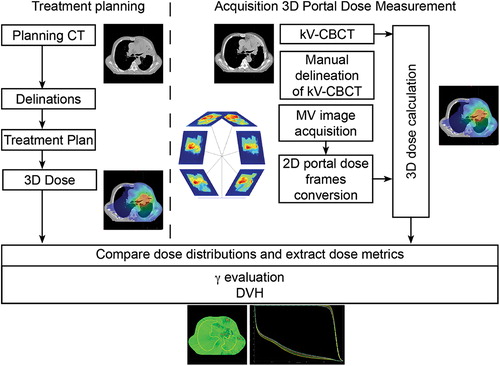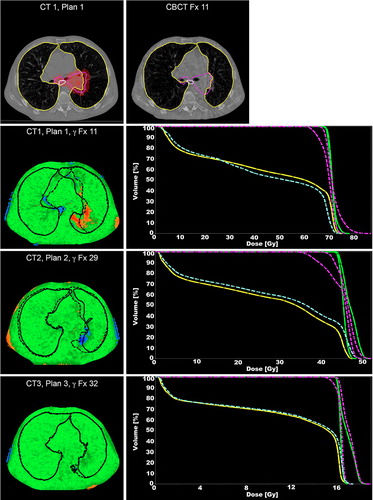Figures & data
Figure 1. Workflow of the PDM acquisition and extraction of dose metrics from the DVH and γ evaluations. On the left side a typical treatment planning process is depicted; the acquisition of the planning CT and the delineation of target volumes and organs at risk resulting in a treatment plan and planned or desired dose. This dose is the reference dose and is compared with the PDMs. On the right side the treatment process is depicted, the acquisition of the PDM. First kV-CBCT is acquired for the patient geometry of the day. Second the treatment beam itself is imaged with iTools. The MV image acquisition and the image frames are converted into 2D portal dose frames. Together with the kV-CBCT and the 2D portal dose frames a 3D dose calculation can be performed. This PDM is then compared with a γ evaluation and a DVH comparison to the planned or desired dose, and flagged for further investigation when the γ and/or DVH criteria fail. When it is flagged the kV-CBCT is re-delineated and compared in further detail.

Table I. γ metrics and DVH metrics for the five patient cases. For details see text.
Figure 2. The top left panel shows the planning CT for the 1st treatment plan of case B with delineations of the lungs (yellow), esophagus (white) and CTVs (purple). The 95% isodose is also indicated (red color-wash). Next to the planning CT a re-delineated CBCT slice of fraction 11 is shown. The lower panels show the γ evaluations for fractions 11, 29 and 32, respectively. Voxels failing the (3%, 3 mm) criteria show up in blue (under dosage) and red (overdosage). The lungs are drawn in black, the dashed lines are the CBCT delineations and the solid lines are the planning CT delineations. Next to the γ plots are the different DVHs for the CTV (planned: green; measured: purple) and the esophagus (planned: yellow; measured: blue).

